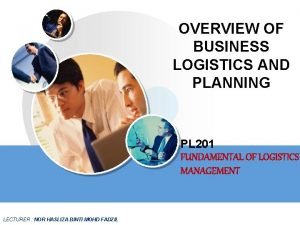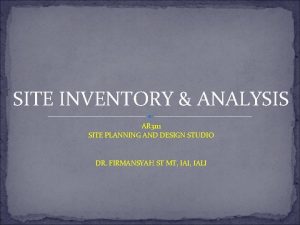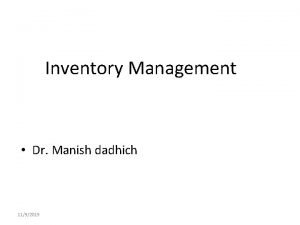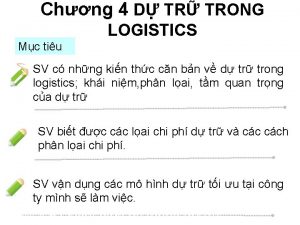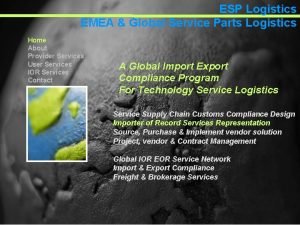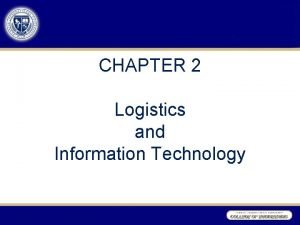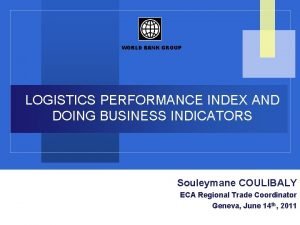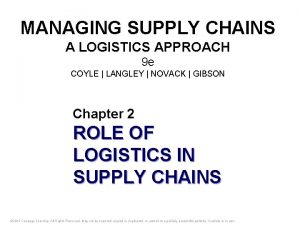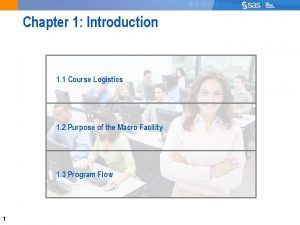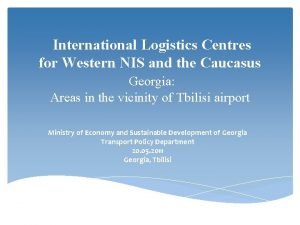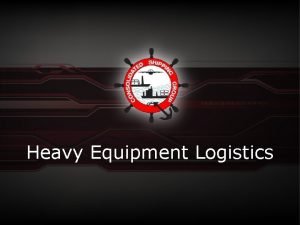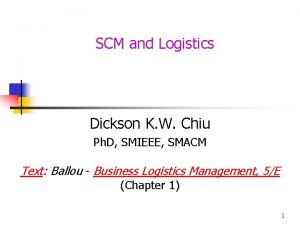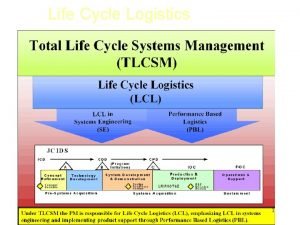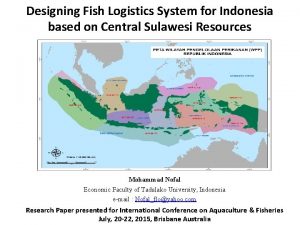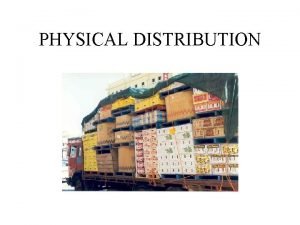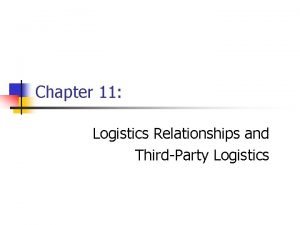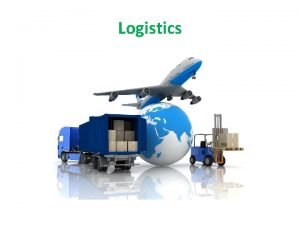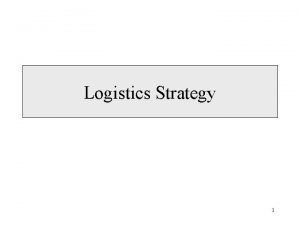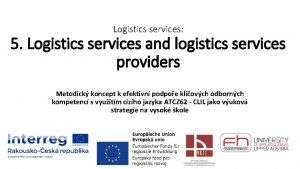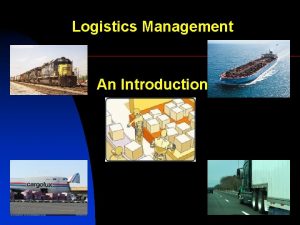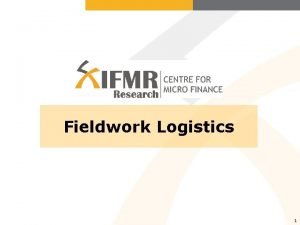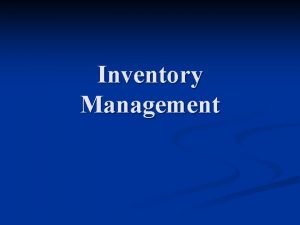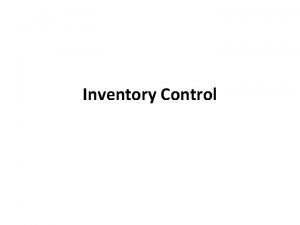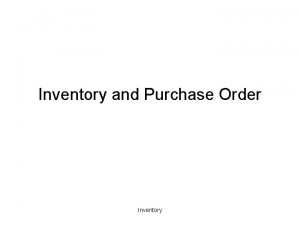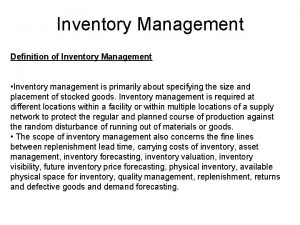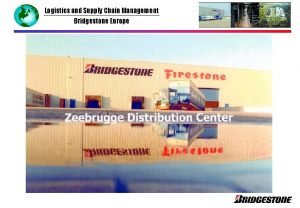INVENTORY IN LOGISTICS Importance of Inventory Inventory in






















- Slides: 22

INVENTORY IN LOGISTICS Importance of Inventory • Inventory in the Economy : Ratio of inventories to GNP decreasing due to (1) Hi quality transportation service reducing the need to carry hi stocks (2) IT assists the management of stock (3) Management of stocks efficient

INVENTORY IN LOGISTICS Importance of Inventory • Inventory in the Firm : – Growth in Inventory Cost • Increase product variety => increase stock levels – Inventory as a % of Value Added • Inventory expense calculated as a % of value added – Current Trends Towards Shifting Inventory in the Distribution Channel • Reductions in inventory levels for one company places pressure on suppliers while the expense passes to the customer. Win-win situation required.

INVENTORY IN LOGISTICS NEED FOR EFFECTIVE INVENTORY MANAGEMENT • The problem of Peak Demand: Seasonally problems need to analysed If prod capacity set to meet peak demand => in off-peak time prod is underutilising capacity • The Need for Storage: Allow production to be used uniformly (Production smoothing)

INVENTORY IN LOGISTICS Rational for Carrying Inventory • Materials Inventories – Purchase Economies: Buy in large quantities (price discounts) and increased inventory costs are less than purchase price (offshore sourcing) – Transportation Savings: Discounts available for transporting large quantities or full containers – Safety Stock : Prevent production shutdown. Cost trade-off : Stock holding cost V's stockout cost – Speculative Purchase: future price increases, strikes, changing political policies, delayed deliveries, interest rates, currency fluctuations

INVENTORY IN LOGISTICS Rational for Carrying Inventory (contd) – Seasonal Supply: Availability of raw materials, transportation means affects availability – Maintenance of Supply Sources: Purchase semifinished items from supplier when capacity not available in firm

INVENTORY IN LOGISTICS Rational for Carrying Inventory (contd) • Physical Distribution Inventories – Transportation Savings: Transport economies – Production Savings: No prod interruptions – Seasonal Demand: Storage available during low demand periods – Customer Service : Trade-off between cost of lost sales and inventory cost – Stable Employment : Long-run labour cost and quality – Goods for Resale: Meet timely customer needs

INVENTORY IN LOGISTICS • Functional Types of Inventory – Cycle stock : Stock depleted through normal sale or use and unplenished through the routine ordering process. Firms hold cycle stock to respond to demand or usage occurring under certainty of demand lead time length – Goods in process and goods in transit: WIP refers to the manufacturing time for products, Goods in transit refers to inventory a carrier is transporting to the firm – Safety stock/buffer stock: protects against uncertainties in demand rate, lead time (held in addition to SS)

INVENTORY IN LOGISTICS – Seasonal stock: Accumulation of stock in advance of peak demand – Promotional stock: Accumulation of stock so Logistics can respond to a marketing promotion of price deal offered to customers – Speculative stock: Protects against price increased or constrained availability – Dead stock: Stock which has no value for normal business purposes

INVENTORY IN LOGISTICS • Importance of Inventory in Other Functional Areas – Marketing: Hi customer service levels, stocks to assure product availability and meet customer needs as quickly and completely as possible – Manufacturing: Long production runs and low procurement costs – Finance: Low inventories to increase inventory turnover, reduce current assets and receive hi capital returns on assets CONFLICTS OCCUR BETWEEN AREAS! A formal logistics organisation could help resolve these conflicts with proper inventory mgt.

INVENTORY IN LOGISTICS Inventory Costs • Represent a significant component of total logistics costs • The inventory levels affect the level of service to the customer • Cost trade-off decisions in Logistics depend on and affect inventory carrying costs

INVENTORY IN LOGISTICS Inventory Costs • Inventory Carrying Cost – Capital Cost: Interest/opportunity cost focuses on “What is the implicit value of having capital tied up in inventory instead of using it in some other worthwhile project” Expressed as a % of the pound value of the inventory the company holds. Calculate the capital cost for inventory decision involves: identifying the Hurdle Rate (min rate of return expected of new investments)

INVENTORY IN LOGISTICS Inventory Costs (contd) – Storage Space Cost : Includes handling costs associated with the movement of products, and storage costs. Include variable rather than fixed expenses when estimating space costs as well as capital costs – Inventory Service Cost: Insurance and taxes. – Inventory Risk Cost: Goods held may become obsolete, damaged, stolen, etc.

INVENTORY IN LOGISTICS Inventory Costs • Calculating the Cost of Carrying Inventory – Identify the value of the item stored in inventory • Approached include FIFO, LIFO and average cost • Value measurement is the cost of goods sold or the variable manufactured cost of product currently coming into the firm’s logistics facilities • Measure of each individual carrying cost component as a % of product value, and add %’s to measure inventory carrying costs. • Multiply overall carrying cost by the value of the product

EXAMPLE Mfg. Of Hard Disks for P. C. ’s at variable mfg. Cost of $100/unit Carrying costs as a % of product value as follows: COST % of Product Value Capital 12 Storage space 6 Inventory service 4 Inventory risk 3 ---Total 25 Annual cost of carrying a single hard disk in inventory = $100 X 25% = $25/year

INVENTORY IN LOGISTICS Inventory Costs • Nature of Carrying Cost Items with similar carrying costs should use the same estimate of carrying cost per inventory dollar Items subject to obsolescence/require servicing may require cost estimates – Cost relationships: Carrying cost is variable and is directly proportional to the number of average inventory units/average inventory value

Inventory Costs • Order/Setup Cost – Order Cost: Expense of placing an order for additional inventory (does not include the cost of the product itself). • Fixed and variable component. – Fixed may refer to I. S. and Facilities available to facilitate order placement, this cost remains constant in relation to the number of orders placed. – Variables results from (1) reviewing the inventory stock level, (2) preparing and processing an order requisition/purchase request, (3) selecting a supplier, (4) preparing and processing the purchase order, (5) preparing and processing receiving reports, (6) checking and inspecting stock and (7) preparing and processing payment

Inventory Costs • Setup Cost : Expense of changing a production/assembly process to facilitate product line changeovers. – Use of capital equipment (fixed) – Personnel costs (variable) • Nature of Cost: Identify the fixed and variable costs. Yearly order costs start with the cost or charge associated with each individual order or setup. Annual order costs will increase in direct relation to the number of orders placed/year

Inventory Costs • Carrying Cost V’s Order Cost – Order cost and carrying cost respond oppositely to changes in order number/size – Total cost responds to the changing order size – Order cost decreases quicker than carrying cost increases (graph) • Expected Stockout Cost – Safety Stock : protects against uncertainties in demand/lead time • Level of SS : Determine a % carrying cost (including capital cost, storage space, inventory service cost and inventory risk cost) X$X no. units

Inventory Costs – Cost of lost Sales • Determine backorders, lost sales and lost customers • Inventory in Transit Carrying Cost – FOB company selling is responsible for transporting product to customer. Delivery time is part of carrying cost. Trade off between transportation cost and cost of carrying inventory in transit. – Determining cost: Capital cost, storage space cost, inventory service cost, inventory risk cost

Inventory Costs 1. Capital cost of carrying inventory in transit = inventory in w/h 2. Storage space not relevant as transporter includes equipment costs etc. in the overall price 3. Insurance requirements need to be analysed 4. Obsolescence low risk as transportation times are generally short

CLASSIFYING INVENTORY • ABC Analysis – Classify according to relative sales volume, cash flows, lead time, or stockout costs System assigns items to 3 groups with the most important items classed as A etc. • 80 -20 Rule – 20% commerce students taking subject A generate 80% first class honors in that subject • Critical Value Analysis (CVA) classifies inventory items by assigning point values for 3 to 5 categories. Top, high, medium, low priorities assigned for 3 to 5 categories • The above are good for effective decision making

EVALUATING THE EFFECTIVENESS OF A COMPANY’S APPROACH TO INVENTORY MANAGEMENT • Are company’s customers satisfied with existing customer service levels – Customer loyalty – Order cancellation experience and stockouts – Relationship with all channel partners • How frequently is there a need for backordering/expediting • Inventory turnover measures for individual lines and products • Does overall inventory as a % of sales rise/fall as sales increase
 Physical distribution performance cycle
Physical distribution performance cycle Difference between site inventory and site analysis
Difference between site inventory and site analysis Sos analysis
Sos analysis Dự trữ trong logistics
Dự trữ trong logistics Esp logistics technology
Esp logistics technology Logistics information technology
Logistics information technology Delmar custom broker
Delmar custom broker World bank logistics index
World bank logistics index Managing supply chains a logistics approach
Managing supply chains a logistics approach Paradoxes of green logistics
Paradoxes of green logistics Token logistics llc
Token logistics llc Global logistics centre
Global logistics centre Logistics equipment introduce
Logistics equipment introduce Logistics strategy triangle
Logistics strategy triangle Tlcsm
Tlcsm Market logistics objectives
Market logistics objectives Fish-logistics
Fish-logistics My logistics
My logistics Optimale losgröße
Optimale losgröße Logistics and supply chain management
Logistics and supply chain management Gaf global logistics pvt ltd
Gaf global logistics pvt ltd Elves logistics federation
Elves logistics federation Mbm group
Mbm group
